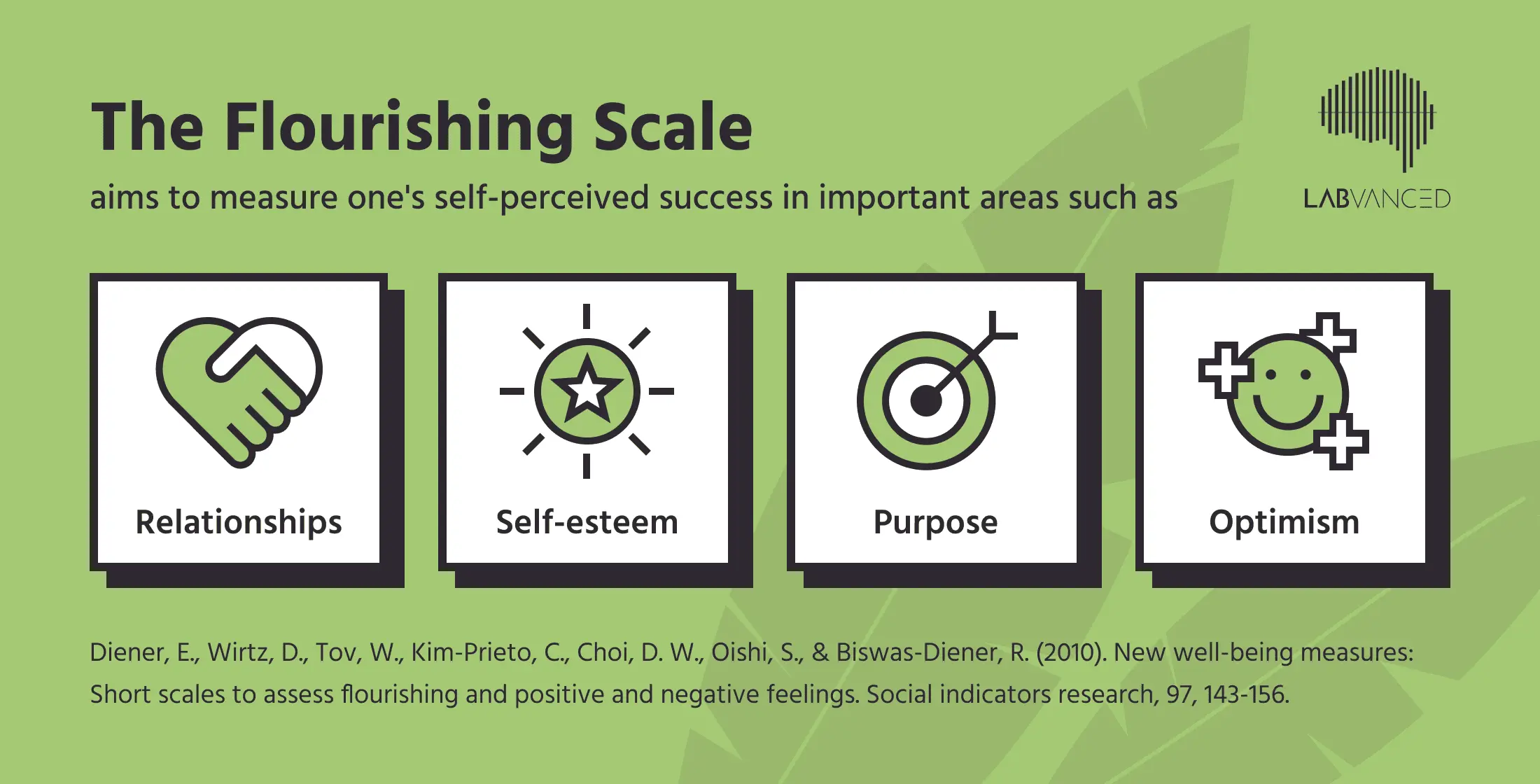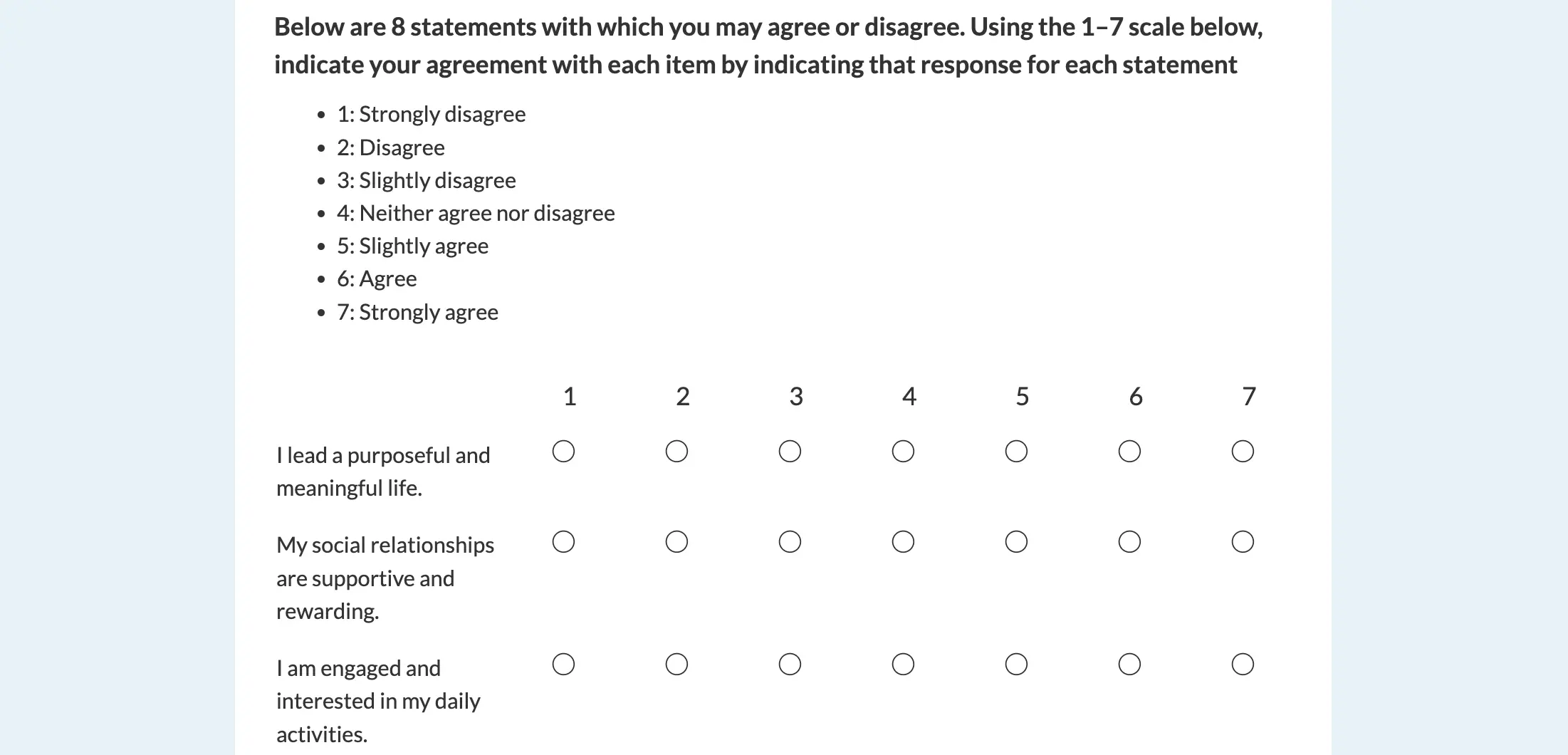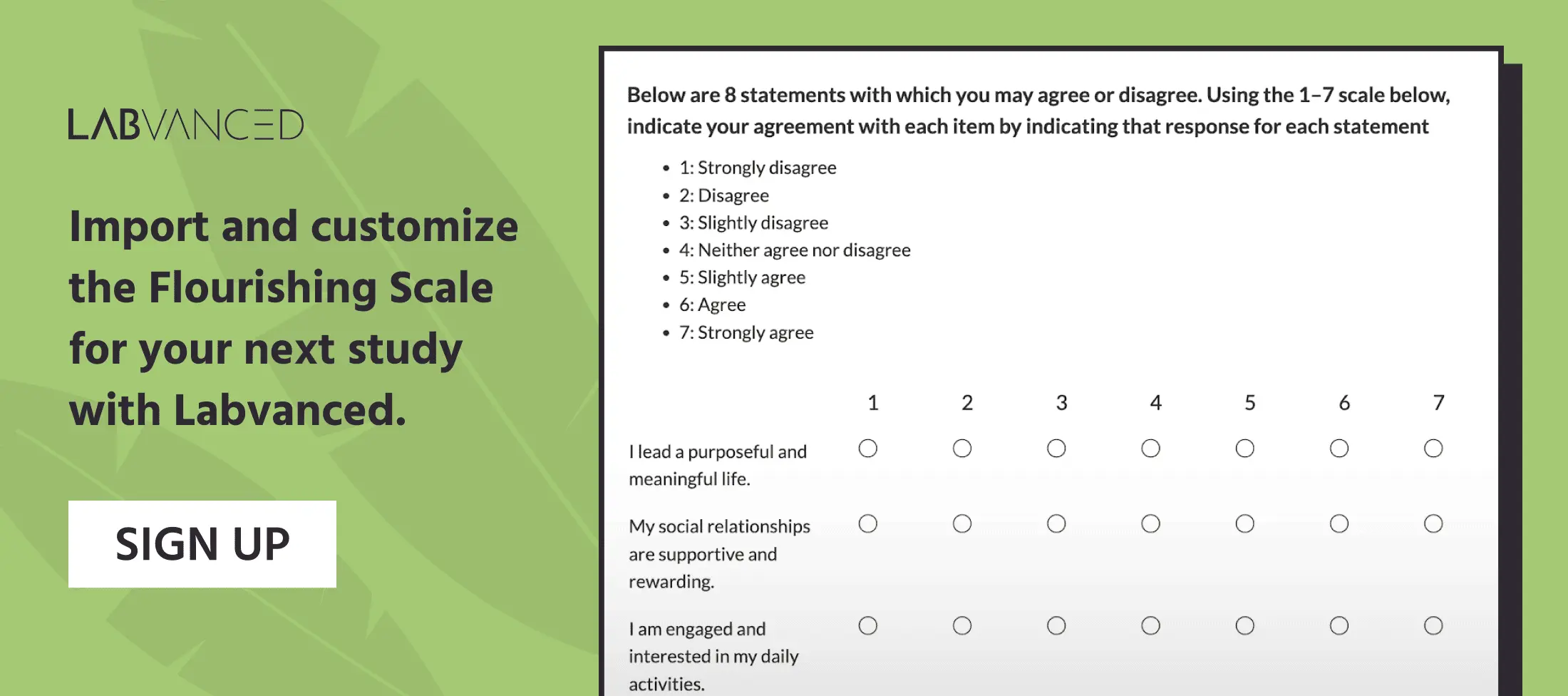
The Flourishing Scale (FS) Questionnaire
The Flourishing Scale (FS) is a simple and straightforward assessment tool (8-item questionnaire). Researchers using the FS seek to measure an individual's self-perceived success in various domains of life, such as self-esteem, purpose, optimism and success in relationships. Based on the participant’s answers, a single score for ‘flourishing’ is calculated. By assessing these key dimensions, researchers and individuals can reflect on their overall life functioning and fulfillment. The scale has proven to be a reliable and user-friendly tool in both research and practical applications, assisting individuals, researchers and professionals in identifying strengths and possible areas for growth in the pursuit of living a fulfilling life!
History of the Flourishing Scale
The Flourishing Scale was created with the overall aim of establishing a reliable measure of well-being based on modern psychological theories, like positive psychology. In recent years, findings in the domain of psychology have pointed out that to understand an individual’s well-being, it’s not just important to measure their level of happiness, but also to consider several other factors which ultimately play an important role in living a fulfilling life.
Edward Diener, a prominent psychologist and researcher in the field of subjective well-being, recognized that the measures of happiness which were used at the time often neglected key aspects of wellbeing. Thus he set out, together with his colleagues, to create a multidimensional measure of wellbeing wherein additional factors are considered. Thus, the Flourishing Scale was developed as an attempt to provide researchers with a means for better understanding what it means to ‘flourish’ and prosper in life (Diener et al., 2009).

To develop the scale as we know and use today, the development process involved extensive research, including pilot studies and feedback from diverse populations which included a mix of genders coming from various backgrounds. As a result, Diener and his team did their part to ensure that the scale would be able to reflect different domains of well-being that are most relevant to an individuals' life. The Flourishing Scale was first published in 2009, and thereon, many studies demonstrated its strong psychometric properties, including high reliability and validity. Now, the FS is used as a standard measure for assessing psychological well-being in both academic research and practical applications (Weziak-Bialowolska et al., 2021).
Structure of the Flourishing Scale Questionnaire
The Flourishing Scale comprises eight items that measure various aspects of psychological well-being. Each statement of the scale reflects a different dimension of flourishing, such as the quality of interpersonal relationships, feelings of self-esteem, having a sense of purpose in life and optimism. Respondents are expected to rate their level of agreement with a presented statement using a 7-point Likert scale, where 1 indicates "strongly disagree" and 7 "strongly agree", ensuring a detailed understanding of a respondent's self-perception in critical areas described above.
Example of items included in the Flourishing Scale:
- I lead a purposeful and meaningful life.
- My social relationships are supportive and rewarding.
- I am engaged and interested in my daily activities.

The Flourishing Scale questionnaire, as shown above, can be imported to your Labvanced account by clicking on the ‘Import’ button here.
Another interesting factor of this scale is its phrasing of statements in a positive tone. For example, the items include assertions like "I am a good person and live a good life" or "I am optimistic about my future." This encourages the respondents to focus on their positive strengths and experiences. The scale is structured in a way that it's accessible and comprehensible to a wide range of populations, including students, professionals, and also individuals seeking personal growth (Diener et al., 2010).
Scoring the Flourishing Scale
The Flourish Scale items are summed. The lowest score obtainable is 8 and the highest score is 56. can have a total score that can be as low as 8 to a maximum score of 56. Higher scores indicate a positive self-assessment of well-being, ie. that the respondent has many strengths and psychological resources.

The Flourishing Scale in Research
The Flourishing Scale is widely used in research to measure wellbeing across diverse populations and contexts. Listed below are a few examples of the studies where the Flourishing Scale was incorporated to measure well-being across various groups and populations:
- Working population: A study by Du Plessis et al., (2023) aimed to find if positive coping behaviors played a mediating role between trait emotional intelligence and flourishing and also to explain how certain characteristics influence behavioral outcomes at work. The findings pointed out that individuals, when they have higher emotional intelligence, tend to engage themselves in more positive coping behaviors and this further enhanced their flourishing.
- Adolescents: Tan et al., (2021) performed a study with the objective of examining longitudinal measurement invariance, regarding Flourishing Scale (FS), to see whether it is consistently measuring eudaimonic well-being across time points and whether scores can be compared between male and female groups among Chinese adolescents. The study findings implied that the FS can reliably measure the same construct of eudaimonic well-being over time and is valid for comparing differences in scores between males and females.
- Undergraduates: Belen et al., (2020) in their study examined the relationship between fear of happiness and flourishing among Turkish undergraduate students. They also investigated whether the relationship was mediated by their levels of hope. The study found that experiencing less fear when it comes to happiness-related activities increased the students’ motivation for achieving desired goals and their perceived capacity to create a path toward these goals, which in turn enhanced their levels of flourishing.
Conclusion
The Flourishing Scale (FS) is a prominent tool to assess well-being of an individual, covering critical domains like relationships, purpose, self-esteem and optimism. It is a widely used tool because of its good psychometric properties, including reliability, which allows researchers to administer it across diverse populations. Also, it is not very demanding to administer as it is only 8 items that the respondent must fill. The Flourishing Scale continues to be a valuable resource to promote well-being and enhance individuals' understanding of their own flourishing!

References
- Belen, H., Yildirim, M., & Belen, F. S. (2020). Influence of fear of happiness on flourishing: Mediator roles of hope agency and hope pathways. Australian Journal of Psychology, 72(2), 165–173. https://doi.org/10.1111/ajpy.12279
- Diener, Ed, Wirtz, D., Tov, W., Kim-Prieto, C., Choi, D., Oishi, S., & Biswas-Diener, R. (2009). New well-being measures: Short scales to assess flourishing and positive and negative feelings. Social Indicators Research, 97(2), 143–156. https://doi.org/10.1007/s11205-009-9493-y
- Diener, Edward, Wirtz, D., Tov, W., Kim-Prieto, C., Choi, D., Oishi, S., & Biswas-Diener, R. (2010). Flourishing scale. PsycTESTS Dataset. https://doi.org/10.1037/t03126-000
- Du Plessis, M. (2023). Trait Emotional Intelligence and flourishing: The mediating role of positive coping behaviour. SA Journal of Industrial Psychology, 49. https://doi.org/10.4102/sajip.v49i0.2063
- Tan, Q., Zhang, L., Li, W., & Kong, F. (2021). Longitudinal measurement invariance of the flourishing scale in adolescents. Current Psychology, 40(11), 5672–5677. https://doi.org/10.1007/s12144-021-01754-z
- Weziak-Bialowolska, D., Bialowolski, P., Lee, M. T., Chen, Y., VanderWeele, T. J., & McNeely, E. (2021). Psychometric properties of flourishing scales from a comprehensive well-being assessment. Frontiers in Psychology, 12. https://doi.org/10.3389/fpsyg.2021.652209